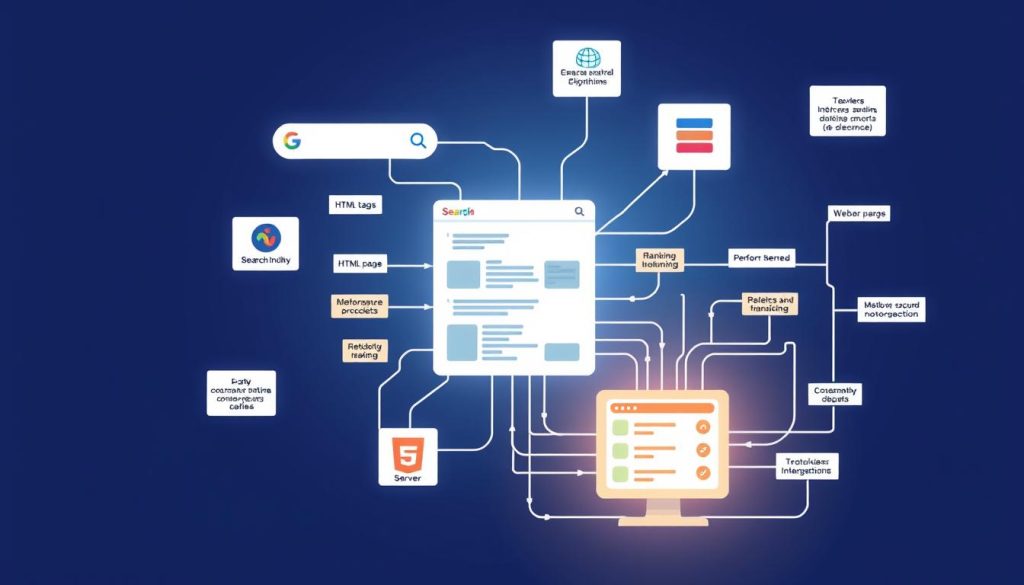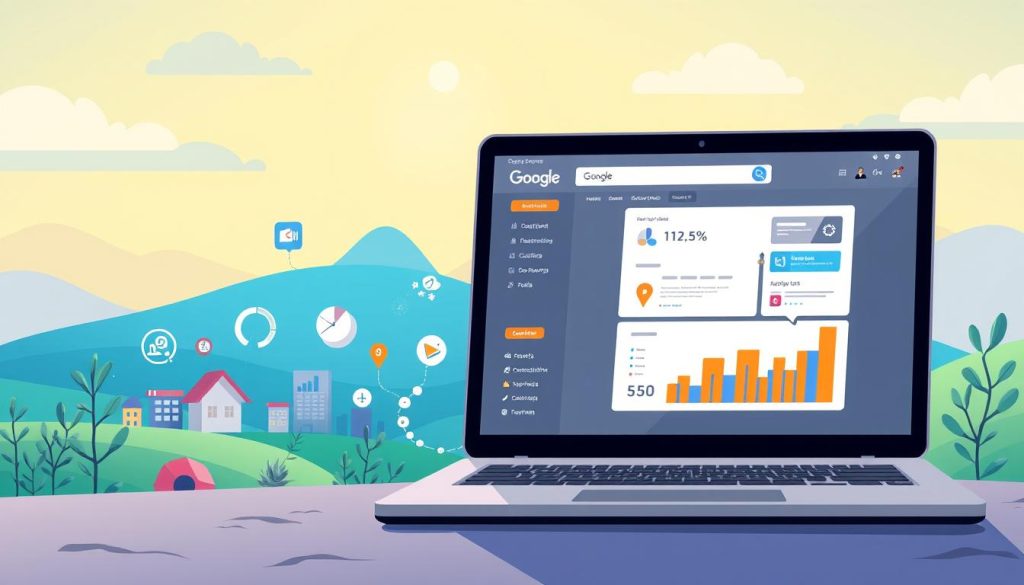The latest Google Update makes user experience, relevance, and technical skills more important than ever. Mastering SEO optimization is now a must for businesses to be seen in search results.
The ultimate On-Page SEO Checklist for 2025 is here. It helps startups, local businesses, and digital marketers lead in the Google rankings race.
By following these 15 easy steps, you can make your website more visible. This will bring more visitors to your site.
Table of Contents
Main Objectives
- Understand the importance of SEO optimization in 2025
- Learn how to improve your website’s Google rankings
- Discover the ultimate On-Page SEO Checklist for 2025
- Boost your website’s visibility with easy-to-follow steps
- Stay ahead in the SEO race with the latest techniques
The Evolution of SEO in2025
SEO strategies have changed a lot in 2025 with the latest Google update. Now, search engines care more about how users feel and the site’s technical skills. Businesses need to update their SEO plans to stay ahead.
Key Algorithm Changes Affecting Rankings
New algorithm updates have changed how search engines rank websites. Enhanced E-E-A-T (Expertise, Experience, Authority, and Trustworthiness) criteria are now stricter. This means content needs to be top-notch and trustworthy.
Also, user experience metrics like how fast a page loads and how it looks on mobile are key. These are now important for ranking.
Why On-Page Optimization Remains Critical
Even with changes, on-page optimization is key for good search rankings. It involves smart keyword use, better title tags and meta descriptions, and clear URLs.
It’s not just about keywords anymore. It’s about making the site easy to use and match search engine rules.
Complete On-Page SEO Checklist for2025
To make your website more visible on Google, follow a detailed on-page SEO guide for 2025. This checklist will help you optimize your site well. It keeps you ahead of your rivals.
1. Conduct Strategic Keyword Research
Keyword research is key for a good SEO plan. It finds the search terms your audience uses for content like yours.
Using Advanced Keyword Tools
Use tools like Ahrefs, SEMrush, or Moz for keyword research. They show search volume, competition, and related keywords.
Analyzing Search Intent
It’s important to know what people are searching for. Look at top pages for your keywords to see what content works best.

2. Optimize Title Tags for Maximum Impact
Title tags are vital for SEO. They tell search engines what your page is about. Make them descriptive, include your keyword, and be catchy to boost clicks.
3. Craft Compelling Meta Descriptions
Meta descriptions give a quick summary of your page. Write them to be informative, include your keyword, and make users want to click.
4. Structure URLs for Clarity and SEO
A clear URL is good for both users and search engines. Make sure your URLs are easy to understand, include your keyword, and are short.
5. Implement Header Tags Strategically
Header tags (H1, H2, H3, etc.) organize your content. They make it easier to read and for search engines to understand. Use them to highlight important points and structure your content.
Content Optimization Techniques
To win in SEO, businesses need to use advanced content optimization. This makes content good for both users and search engines. It’s key to On-Page SEO, making sure content is high-quality and meets the audience’s needs.
6. Create High-Quality, E-E-A-T Compliant Content
It’s important to make content that follows Google’s E-E-A-T rules. E-E-A-T means Experience, Expertise, Authoritativeness, and Trustworthiness.
Demonstrating Expertise and Authority
Content should be well-researched and written by experts. Showing you’re an expert means sharing your knowledge and credentials.
Building Trust Signals
It’s key to build trust with your audience. Give accurate info, use credible sources, and be open. Trust signals like reviews help too.
7. Optimize for Featured Snippets and Position Zero
Optimizing for featured snippets boosts your visibility. Focus on giving direct answers to common questions.
- Use a question-and-answer format.
- Keep answers short, 40-60 words.
- Use header tags for important info.
8. Incorporate Semantic Keywords and Entities
Using semantic keywords and entities helps search engines get your content. Use related terms and phrases linked to your main keyword.
For example, if your main keyword is “content optimization,” use “SEO strategies,” “keyword research,” and “on-page SEO” too.
9. Improve Content Readability and User Experience
Make your content easy to read and use. Use clear headings, short paragraphs, and bullet points or numbered lists.
- Break up long paragraphs.
- Use subheadings to organize.
- Make sure it works on all devices.
10. Implement Regular Content Audits and Updates
Regularly check and update your content. Review what you have, update old info, and remove or merge what’s not needed.
Using these techniques can greatly improve your search rankings and user experience.
Technical On-Page SEO Factors
To stay ahead in SEO, you must master technical on-page SEO. These elements boost your website’s visibility and traffic. They also help improve your search engine rankings.
11. Enhance Page Loading Speed
Page loading speed is key in SEO. It affects user experience. A slow site can lead to more bounces and lower rankings.
Core Web Vitals Optimization
Core Web Vitals measure a webpage’s user experience. Improving Largest Contentful Paint, First Input Delay, and Cumulative Layout Shift boosts speed.
Image and Script Optimization
Optimizing images and scripts speeds up your site. Compress images, minify CSS and JavaScript, and use browser caching.
12. Ensure Mobile-First Optimization
Most internet users use mobile devices. So, mobile-first optimization is key. Make sure your site works well on all devices.
13. Optimize Images with Alt Text and Compression
Optimizing images means adding alt text and compressing them. This speeds up your site and makes it more accessible.

14. Implement Schema Markup for Rich Results
Schema markup helps search engines understand your webpage. It makes your site more visible in search results, driving more traffic.
15. Improve Internal Linking Structure
A good internal linking strategy improves user experience. It also helps search engines crawl your site better.
Strategic Anchor Text Usage
Use descriptive anchor text for internal links. It enhances user experience and helps search engines understand your links.
Fixing Broken Links
Broken links harm user experience and rankings. Regularly check and fix broken links to keep your site healthy.
| Technical SEO Factor | Description | Impact on SEO |
|---|---|---|
| Page Loading Speed | Improves user experience and search engine rankings | High |
| Mobile-First Optimization | Ensures responsiveness across devices | High |
| Image Optimization | Enhances page loading speed and accessibility | Medium |
| Schema Markup | Improves visibility in SERPs | High |
| Internal Linking Structure | Enhances user experience and search engine crawling | Medium |
Conclusion: Implementing Your On-Page SEO Strategy
Following the On-Page SEO Checklist2025 can greatly improve your search rankings. The 15 easy steps in this guide are key to a good on-page SEO strategy.
SEO needs constant work and keeping up with new trends. Regularly check and update your SEO plan to stay ahead. This will help you succeed in the long run.
Create high-quality, E-E-A-T compliant content that your audience loves. Use technical SEO like fast page loading and mobile-first design. This will make your site better and attract more visitors.
A solid on-page SEO plan boosts your online presence. It drives more traffic and increases your business’s profits.



